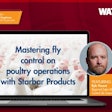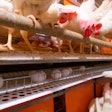Removing anticoccidials costs producers more than it saves.
In a WATT Poultry Chat interview, Dr. Chase Miller, a poultry technical consultant with Elanco Animal Health, spoke about his experiences in the field with coccidia and coccidiosis and why producers need to maintain their programs.
Austin Alonzo: Chase, as veterinarian who works on coccidia programs. What types of conversations have you been having with your customers lately?
Dr. Chase Miller: Yeah, I think it's an exciting time to be a veterinarian in the industry today. The market conditions: There's high input costs going in, but we haven't seen value of chicken, like we've seen today, maybe this century. And so I think as we think about that, my dad used to tell me when I was playing baseball, it's a heck of a lot more fun to win than it is to lose. I think the same is true in the chicken industry, it's a whole lot more fun to make money than to lose money.
So, when we think about bird health and coccidia control, it kind of relates to that. We've got such a high value of chicken right now, every pound to the plant matters. When we're talking about coccidia control, we've seen a trend in the past couple of decades, maybe where high input cost would lead producers to try to pull some things from the diet. They try to minimize or reduce some of the cost of the diet across the life of the bird. That would look like potentially even pulling out some coccidia control from some of the later feeds. The data that we have on file from 2021 shows the average feeding program had about 3.8 rations in it. Of that third ration feed, about half of those had some sort of anticoccidial control in them. That reduced down to 6%. When you got to that fourth feed. So, that tells me there's there's quite a few birds being raised on finisher feeds later feed without any anticoccidial control. And as we think about coccidiosis, and some of the impacts that it might have on bird health, bird welfare, and the profitability metrics that our customers are so in tune with, we think of subclinical coccidiosis really dragging down performance. Some of the late cycling coccidiosis that can have an impact on bird livability and bird welfare. And all those get rolled into that net profitability equation that our customers have to work out.
Austin Alonzo: Why would a producer want to remove anticoccidials from later feeds?
Dr. Chase Miller: There are a lot of justified reasons why someone may want to remove and anticoccidials later in those diets. Cost is a big one. That's when we see quite a bit trying to reduce that cost across the diet. Another one might be that they're really trying to set themselves up for good rotation, whether it's summer, rotating to fall, spring rotating to summer, those types of things, managing resistance of toxicity of coccidiosis is always playing in the mind. Then some of the logistical things. Whether it's having a new vendor that's purchasing the chicken meat that needs to fit certain criteria, all these can funnel in and be justified reasons why someone may choose to remove coccidial control from those later feeds.
Austin Alonzo: What are the consequences when they do that?
Dr. Chase Miller: I mentioned it a little bit earlier, subclinical coccidiosis can be a detriment to birds later on in their life. If you have a flare up of coccidiosis late, we call it late cycle coccidiosis, that can also have an impact on performance. And I like to keep in mind, when we're dealing with coccidiosis, we're dealing with two biological beings, we're dealing with the cocci themselves and the bird population. If everything were to fit nicely into the middle of the bell-shaped curve, we'd have a lot of predictability and very little variation. But that's not how biology works all the time. And there's a lot of variation across flock to flock and complex to complex and company to company. By removing anticoccidials from from those later feeds, to me, you just increase some of your potential variation that you might see and that may have an impact on profitability.
Austin Alonzo: How can Elanco help overcome coccidia and coccidiosis challenges then?
Dr. Chase Miller: We have a set team of veterinarians and nutritionists that we live and breathe chickens. That's something that we love to do. We love helping kind of tackle some of these bigger questions. We can also act as a sounding board just for ideas and thoughts. Maybe help add some data, some information to help make these decisions. We like to be as non biased and as objective as possible. We're not always perfect in that, but we do take pride in trying to be as objective as possible and helping and really being that extra set of eyes, and that extra thought process to work through these these questions.
Austin Alonzo: Was there anything else you wanted to add on this topic?
Dr. Chase Miller: It's been a joy to get to work with you to get to work with producers. If there's any way that we can help or any questions that you have as far as coccidia control goes or program planning,. Feel free to reach out to us or visit our website.

















